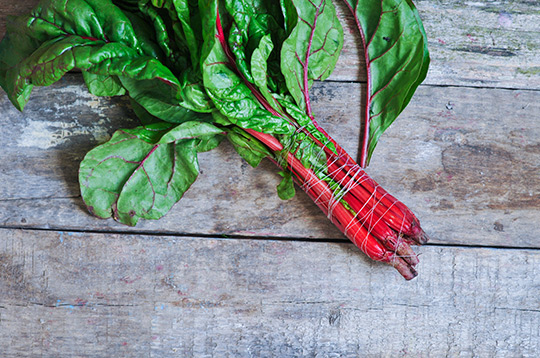
The Bountiful Benefits of Swiss Chard
By Linda Bonvie | 0 Comments | Posted 03/28/2016
Swiss chard has long been a European thing. It is a mainstay of most Mediterranean diets. However, in America, it has found a modest following at best, despite its unique and appealing flavor, along with remarkable health benefits that rate behind only the mighty spinach.
Found in the leafy-green produce section, Swiss chard’s large leaves can present themselves as seemingly tough to deal with in the kitchen. In reality, it is a quick cut-and-cook vegetable item of the highest order, lending itself to speedy, high-impact meals.
Lightly blanched in salted olive oil, topped with butter and a sprinkling of vinegar is all it takes to plate chard in just a few minutes. It can also be served raw; cut into smaller pieces. Raw chard presents well with a few twists of ground pepper, a small pinch of salt and a mild raspberry vinaigrette.
The phytonutrient load in chard is reflected in its often vibrant coloration, ranging from various shades of greens on the leafy part to an array of reds, purples and yellows in the stalk and veins. The more colorful the chard, the higher its nutrient content. When selecting, look for Swiss chard that is firm and vibrantly colored. Avoid leaves that are wilted or drably colored.
The phytonutrients in Swiss chard are just about off the charts. World’s Healthiest Foods website (www.whfoods.com) list Swiss chard bennies as blood sugar regulation, antioxidant properties, anti-inflammatory properties and even bone health.
On the vitamin front, a single cup of Swiss chard provides over 700% of your daily needs for vitamin K and over 200% of daily vitamin A needs.
Flavorwise, chard has been duly likened to a toss-up between celery and spinach, though chard’s taste elements rate as moderate to strong. For this reason it is often cut into small pieces for serving. The entire leaves can be stuffed and wrapped around the likes of herbed rice.
Its strong taste presence also makes chard an excellent addition to soups and, in Cajun country, gumbos. When used as such, the wide-chopped chard is often cooked for much longer periods than in fast-preps. While chard readily adapts to longer, slower cooking, its flavor then becomes instilled in the soup; the chard itself assumes a far more passive taste role.
As a way to get more Swiss chard into one’s daily diet, medicalnewstoday.com suggests:
- Add a handful of fresh Swiss chard to an omelet or scrambled eggs
- Throw a handful of Swiss chard into a fresh juice or smoothie before you blend
- Sauté Swiss chard in a small amount of extra-virgin olive oil and season with freshly ground black pepper and freshly grated Parmesan cheese. Eat as a side dish or as a topping on your baked potato
- Add Swiss chard to your salad, wrap, sandwich or flatbread.


 Contact us
Contact us



























